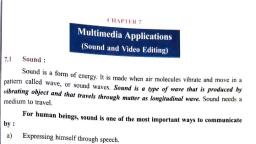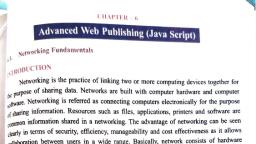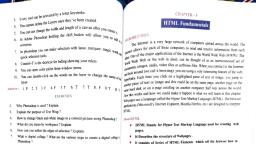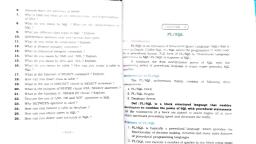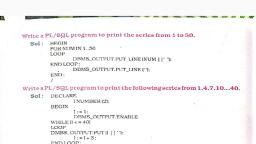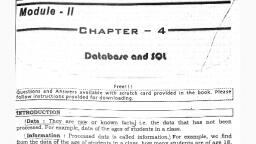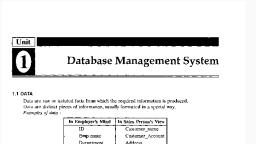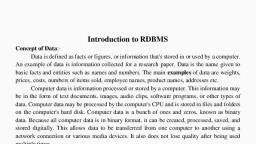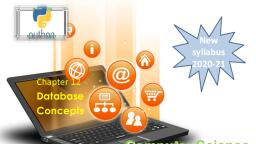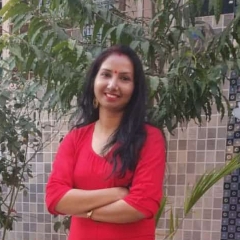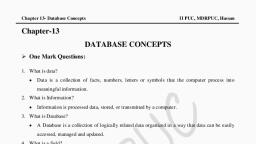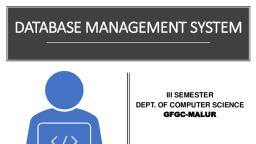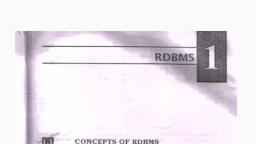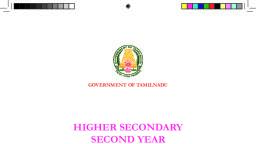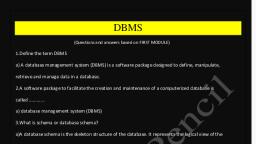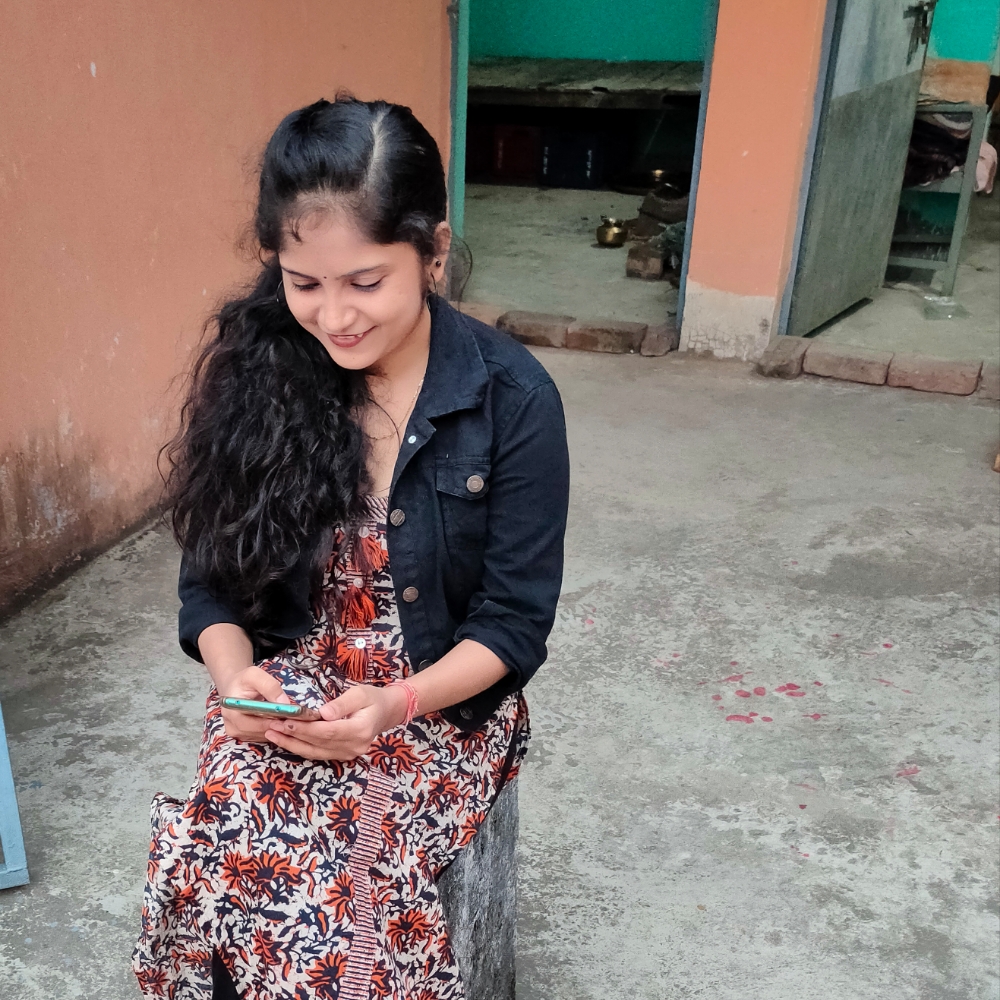Page 1 :
ak be any character, text, word, nu, pat@ atum, which means “To give Something”, p,, that required to be “at is a raw and, , Proc, is the collection of ra essed to make it, , e Data W facts, , Cn different resources. After collection les figures. We, . is, , for processing. entered into, , weve information is data formatted in a manner that all, * utilized by human beings in some significant mele, data is called information. When raw facts and figures aie, and arranged im some proper order then they become, tion. Information has proper meanings. Information is useful in, ‘on- making. Actually we process data to convert it into information., for Example: 1 ,XYZ,15 etc., in the above example the three data items have no meaning. But if, organize these items in following way, then they collectively represent, , mber, Data comes from a, , , , , , , , , , , , RDBMS CONCEPTS AND MYSQL, , Introduction, , The key to organizational success is effective decision Making yj, requires timely. relevant and accurate information. Hence informa, plays a critical role in today’s competitive environment. Databs,, Management Software (DBMS) simplifies the task of managing the tes, and extracting useful information out of it. In this chapter, we shall le,, about the basic concepts of databases., , , , , , information., BASICS OF DATABASE SYSTEM, Roll_No Name Age, Database 1 XYZ 15, , , , , , , , , , , , Database : Database is a collection of inter-related data i.e iti, composed of a collection of files that are linked in such a way, information from one of the files may be combined with info:, from other files so that user may receive the exact informal, needed. For example, school database organizes the data about studen's, teachers, and admin staff etc. which helps in efficient retrieval, inset, and deletion of data from it., , Basic building block of Database is Data. The input to databast, , Information is created from data, , , , known as data and output as information. +, essing, Data and Information Ea, ___ Most people believe that the terms “data” and “informatiom °, interchangeable and mean the same thing. However, there is # al, difference between the two words ‘, Figure. 1, , put, , , , ), (Com,, , — \
Page 2 :
——, , cessing cycle, where ¢,, igure 1 depicts the data pro =, hae sé to be processed into required output in the, proces, , information., , is feq A, for,, , DIKW (Data Information Knowledge Wisdom), , DIKW is the model used for discussion of data, infor, J, knowledge, wisdom and their interrelationships. It represents Struct,, or functional relationships between data, information, know ledge. _, wisdom., , , , pata is stored in records. A record is com, , posed of fields and, tains all the data about one particular Person, c, com, , , , , , , , , , , , , , , , , , , , , , , , , , , , , , , , , , , , , , , , , , , , , , , , , , , , , , ompany, or item in a, _ shane: Records appear as rows in the database table. A record for, RR lL.NO 3 is highlighted in table Student,, —— 5 Student, Information ri ss = ROLL_NO | NAME ADDRESS PHONE AGE, * 100 miles | 1 RAM DELHI XXXXXXXXXX 19, 2 RAMESH SHIMLA XXXXXXXXXX 18, "eens si a | 3 SUJIT | DHARAMSHALA | XXXXXXXXXX 20, © 100 miles is quae e for distance: |) 4‘ |suresu DELHI XXXXXXX | 19, sieseminthtnseeteaniaisitiiieieeniat © Fields, , | * Itis very difficult to walk 100 miles by any person, but vehicle transport, , is okay, , DATABASE ELEMENTS, , d, Tables are also called datasheets, Each table in a database holds, , about a different, but related, su, Student :, , , , , , , Afield is part of a record and contains a single piece of data for the, , Subject of the record. In the database table illustrated in , each record, ‘tains five fields: ROLL_NO.NAME.ADDRESS, PHONE,AGE-Fields, Pear as columns in a database table. Data from the NAME field for four, is highlighted in the table Student below :, , , , , , , , , , , , , , , se tt!, bject. Below is example of databa, , , , , , , , , , oy SCE, (150) Compute!
Page 3 :
SEE ee, , the collection of Information stored i database at a Particy, alled instance of database. lar, , instance of time is ¢@ new, The overall design of the database is calle atabese schema, , AGEMENT SYSTEM), , rpose of database management system is to 1,, , ‘a school that keeps the data of students, teach, e, , courses. books ete. To manage this data we need to store this ee, , somewhere, where we can add new data. delete unused data, Update, , outdated data, retrieve data, to perform these operations on data we, , a database management system that allows us to store the data in such g, , way so that all these operations can be performed on the data efficienty,, DBMS stands for Database Management System. A Data Base, , Management System is a system software for easy. efficient and reliab, , data processing and management. It can be used for:, , a, , DBMS (DATABAE MAN., , The main pw, the data. Consider, , 4 Creation of a database., Retrieval of information from the database., , 4 Updating the database., , 4 Managing a database., , We can break it like this DBMS = Database + Management System., Database is a collection of data and Management System is a set of, programs to store and retrieve those data. Based on this we can define, DBMSlike this : DBMS is a collection of inter-related data and set of, programs to store & access those data in an easy and effective, manner. For Example, MySQL, Oracle etc. are popular commercial DBMS, used in different applications., , DBMS allows users the following tasks :, , 3 Data Definition: It helps in creation, modification and removal, of definitions that define the organization of data in database., , a Data Updation: It helps in insertion, modification and deletion, the actual data in the database., , f, jences!, , (152) [Computer S¢, , , , , , — —, , al : It helps in i, , rm Retriev: P' retrieval of datz, , omach can be used by applications for ‘dene cae atsbane, , tration : si eae, , user Administ om : Me ReIpa Ad registering and monitori, , Q users: enforcing data security, monitoring aes, maintaining data integrity. dealing with iikurenercunorens, recovering information corrupted by unexpected failure mane, applications, , poms cations where we use Database Management Systems are :, , Telecom : There is a database to keeps track of the information, , e ., regarding calls made, network usage. customer details etc., without the database systems it is hard to maintain that huge, amount of data that keeps updating every millisecond. :, ; Industry : Where it is a manufacturing unit. warehouse or, , distribution centre, each one needs a database to keep the, , records of ins and outs. For example distribution centre should, , keep a track of the product units that supplied into the centre as, well as the products that got delivered out from the distribution, centre on each day; this is where DBMS comes into picture., , e Banking System : For storing customer info, tracking day te day, credit and debit transactions, generating bank statements etc. All, this work has been done with the help of Database management, systems., , ® Sales : To store customer information, production information, and invoice details., , ° Airlines : To travel though airlines. we make early reservations,, this reservation information along with flight schedule is stored, in database., , . Education sector : Database systems are frequently used in, , schools and colleges to store and retrieve the data regarding, , student details, staff details, course details, exam details. payroll, data, attendance details, fees details ete., , Online shopping : You must be aware of the online shopping, , (ts3) [a———_———, ) [ec ‘omputer Science-NI) |
Page 4 :
,, , websites such as Amazon, Flipkart etc. These sites ¢,, product information, your addresses and Preference, tore, , details and provide you the relevant list of products . Crea, your query. All this involves a Database management oie om, , COMPONENTS OF DATABASE SYSTEM, , , , A database system is composed of following component, ., Data :, Hardware, , Software., , Database Access Language, , Users, , which coordinate with each other to form an effecti, fe, system. —_ database, , Software, , Hardware, , , , DATA | Procedures, User |, i, (isa) [ mpuiter Seience-N!!, , 1, , (185), , a- Data is that resource, for which Dei, behind the creation of ppms MS is designed. The, , , is to, typical Database, the user saved Dee and utilize, is present and, , pat:, motive, data. Ina, meta data is stored., is data about th, Metadata is data. This is inf, 01, , the DBMS to better understand the data are stored by, , it., , For example : When you store yourName in a datab:, , DBMS will store when the name was stored in ase <i, what is the size of the name, is it stored as related data to oe ., other data, or is it independent, all this information is cietaeati, , Hardware- When we say Hardware, we mean computer, hard, disks, I/O channels for data, and any other physical component, involved before any data is successfully stored into the, memory.When we run MySQL on our personal computer, then, our computer's Hard Disk, our Keyboard using which we type in, all the commands, our computer's RAM, ROM all become a part, of the DBMS hardware., , Software- This is the main component, as this is the program, which controls everything. The DBMS software is more like a, wrapper around the physical database, which provides us with, an easy-to-use interface to store, access and update data. The, , DBMS software is capable of understanding the Database Access, , Language and interpret it into actual database commands to, , execute them on the database., , Data base access language- Dat, simple language designed to write commands to acce!, update and delete data stored in any database. A user can write, commands in the Database Access Language and submit it to the, DBMS for execution, which is then translated and etecutes) by, the DBMS. User can create new databases, tables. ins¢! =, fetch stored data, update data and delete the data using, , access language., , (am, , abase Access Language is a, ss, insert,, , , , wei]
Page 5 :
5. Users- Users are those persons who need the information, the database to carry out their primary business respons;, ie. Personnel, Staff, Clerical. Managers, Executives ete. On, basis of the job and requirements made by them they, provided access to the database totally or partially., , The various types of users which can access the database are,, , e Database Administrators (DBA), , @ Database Designers, , e End Users, , e@ Application Programmers, RDBMS (Relational Database Management System), , RDBMS, , RDBMS stands for “Relational Database Management System. An, RDBMS is a DBMS designed specifically for relational databases,, Relational Database Management System (RDBMS) is an advanced, version of a DBMS system. It came into existence during 1970's. RDBMS, , system also allows the organization to access data more efficiently then, DBMS., , , , Relational Database - A relational database refers to a database, that stores data in a structured format, using rows and columns. This, makes it easy to locate and access specific values within the database. It, is “relational” because the values within each table are related to each, other. Tables may also be related to other tables, The relational structure, makes it possible to run queries across multiple tables at once., , A relational database management system (RDBMS) is 4, Program that allows you to create, update, and administer 4, relational database. Most relational datab:, the SQL language to access the database. An RDBMS is a type of DBMS, with a row-based table structure that connects related data elements and, , includes functions that maintain the security, accuracy, integrity and, consistency of the data., , , , , , asé Management systems use, , (156) [ Computer Science Xl}, , Tom,, Tbilitieg, , the, , , , , , a, s a software system whic, ., BMS is @ st Which is Used, , a stored in the form of tables. In this ‘0 store only data which, , oe and stored in rows and columns Which ig, _— oe data is, , ma utes: RDBMS is a powerful data m, chee 5 ‘uples and, , atti cross the world. Example of RpB and is widely, ac!, , used, , ete:, , Oracle, SQL Server,, qraditio, , qraditional File Processing Systems :, m where all theinformation is stored, ste!, , aditional files system stores data, , ‘anagement gy;, MS is Mysqu,, , nal File System, , It is totally computer based, in different computer files,, - ‘ a in a manner that all the, parements of an organization have their own set of files that creates, - sqquadaneye, But this system is good only for small Organizations having small, per of items. In this traditional file system, each file is independent of, a file and data in the different file can be integrated only by writing an, , individual program for each application., , A file system is a method for sorting and organizing computer, files and the data they contain to make it easy to find and access, them. , To illustrate Traditional File Processing Systems definition, lets us, take an example of school where student record for examination is stored, in other file and his library record is stored in different file that creates, many duplicate values like roll Number, Name and Father Name., , Characteristics OF Traditional File Processing System, , @ It stores data of an organization in group of files., © Files carryingdata are independent on each other. ome, ® COBOL, C, C++ programming languages were used to de:, , files., , ® Each file contains data for some specific =, library, student fees, and student examina’ , ® It is less flexible and has many limitations., , area or department lik, , , , tl ——_______, 87) omputer Science: xi |

